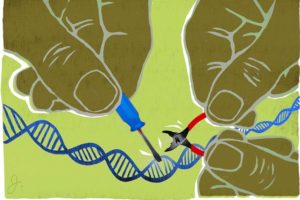If you haven’t seen the cinematic masterpiece that is Jurassic Park, drop what you’re doing and go watch it now. Even if you don’t dig dinosaurs, there’s an immaculate scene of an injured, bare-chested Jeff Goldblum, and that alone is worth your 2 hours and 7 minutes.

Lusting for a young Jeff Goldblum aside, one thing that resonates scientifically in Jurassic Park, is the ability to piece together bits of prehistoric DNA with frog DNA in order to recreate dinosaurs. It turns out that we’re not too far off from technology like this due to research of several scientists, namely Dr. J. Craig Venter and Dr. Chris Voigt, in addition to the Human Genome Project-Write (HGP-Write).
Both Venter and Voigt are curious about the inner workings of cells. If they can understand what all the bits of DNA within a cell do, it’s possible that they could build a cell programmed to behave a certain way in response to its environment. This could lead to designer microbes that could clean up oil spills or produce pharmaceuticals much cheaper than current drugs.
Dissecting a genome
In an article recently published in Science, Venter’s group at his eponymous institute in La Jolla, CA, began to decode the genome of bacteria. The team used the single chromosome from a bacterium called Mycoplasma mycoides and inserted this DNA into a different bacterium, Mycoplasma capricolum. They observed that M. capricolum was able to thrive with the other bacterium’s DNA in place of it’s own. This is a bit like swapping out the engine of Honda Civic for that of a Ford Fusion.
Venter’s group then began using genetic technology to strip away bits and pieces of this genome to figure out which regions were absolutely essential for survival. They were able to reduce the size of this genome from roughly 1000 genes down to 473 genes. Loss of any other genes led to death of the bacteria. It should be noted that this minimum-genome bacteria is only able to thrive in tightly regulated laboratory conditions, and this doesn’t necessarily translate to the bacteria being able to survive in the harsher conditions of the real world. Regardless, this was a massive feat for synthetic biology, and this minimal genome organism was dubbed JVCI-syn3.0.
Surprisingly, even though Venter’s team was able to discard nearly half of the genes in this organism, there were many stretches of DNA for which there was no known function. These mystery regions included both genes that encode the structure of proteins, and non-coding regions that may regulate how the cell interprets the instructions encoded in the DNA.
In a recent issue of New Scientist, Alistair Elfick, a bioengineer at the University of Edinburgh, described these bits of mystery DNA as “the dark matter of biology.” The goal of this work is ultimately to understand the role of this “dark DNA” in ensuring the survival of its host cell. If we can learn what all of these mystery bits of DNA are responsible for, we’ll be another step closer to understanding the complexities of a genome.
Programming cells to do our bidding
Once we understand all aspects of a genome, how do we start designing cells to perform a specific task in response to a stimulus?
Another team of researchers, led by Chris Voigt at MIT, has created software that will allow synthetic biologists to engineer genetic circuits of genes. This software is based on a programming language, Verilog, which aids electricall engineers in designing functional electrical circuits.

Voigt’s software, called Cello, employs a similar method to identify networks of genes that often work together in cells, thus helping biologists tweak sets of genes and how they react to one another to engineer a certain outcome, such as changing the way a cell metabolizes a certain nutrient. As a proof of principle, a postdoc in Voight’s lab published a paper in 2012 wherein he was able to introduce DNA into E. coli encoding several renditions of a genetic circuit in which a transcription factor (a protein that facilitates a gene within DNA being made into RNA, which then can become a protein itself), a chaperone protein (a protein that helps other proteins become or remain the right shape to be functional), and another gene of interest that they inserted. These 3 components were all dependent upon one another for their activity and full execution of this circuit.
“This is the first example where we’ve literally created a programming language for cells,” said Voigt in a Nature News article.
Synthesizing a human genome
An article like this about synthetic genetics cannot possibly conclude without at least a brief mention of the Human Genome Project-Write. This project is a long-awaited and logical next step to the Human Genome Project-Read, which entailed the sequencing of the human genome that was launched in 1990.
The HGP-Write, led by Jef D. Boeke, George Church, and Andrew Hessel, includes the broad aim of reducing the cost of synthesizing large genomes, including those of humans and other organisms used in agriculture or for medicinal purposes, and inserting this intelligently designed genetic content into cells. A few highlights of this project include engineering pigs to be a better host for growing human tissues for transplant and engineering human cells to be more resistant to viruses or cancer.
The announcement of this project in June of 2016 followed a clandestine closed-door meeting at Harvard in May. It’s not hard to imagine why the leaders initially desired a modicum of privacy while they discussed their plans: the ethical and logistical implications of artificially creating life are massive. The project is slated to mine the expertise of several labs and cost just shy of $3 billion. You can read the full release at here at Science.
Looking to the future
Pioneers like Venter and Voight and the scientists working on HGP-Write are paving the way for a revolution in synthetic biology wherein we can deliberately design cells, both microbial and mammalian, to perform a specific task. The power to engineer cells has massive implications for the pharmaceutical industry, creating renewable energy sources, and remediating pollutants.
I’m anxiously awaiting the breakthroughs that may come on the heels of this research, though I’m wary of what the critics may say about “playing God” and the roadblocks this research may hit along the way. I don’t expect we’ll soon have an amusement park full of live dinosaurs returned from extinction or Frankenstein-esque synthetic humans, but if this research can work towards preventing a devastating disease, like cancer, or produce economically and environmentally responsible biofuels, sign me up.

Both scientists and non-scientists have spoken out about the dangers of this type of work. Critics claim that the project leaders have not fully solidified nor justified the aims of this project and that more public discourse concerning the implications of such research is needed. With all due respect to the cautious mindsets of the naysayers, I’m (perhaps naively) confident that the benefits and the knowledge we’ll gain about the chemistry of being human far outweigh any perceived risks.
Edited by Deirdre Sackett.
Follow us on social media and never miss a Science News article: